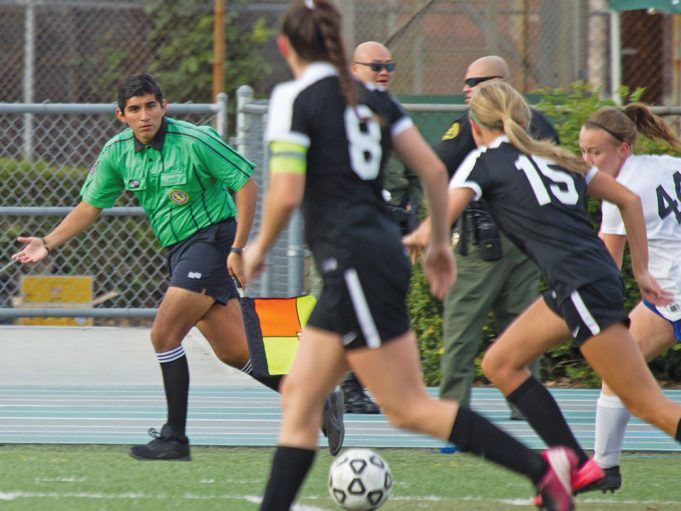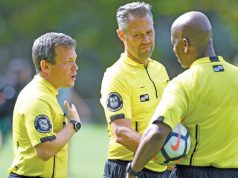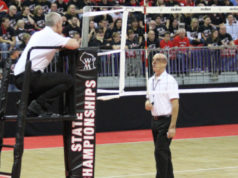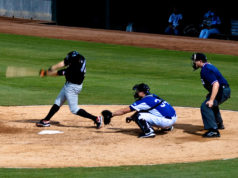Many spectators, most radio/TV commentators, a surprisingly large proportion of coaches and many players simply do not understand Law 11 (Offside). When they think about it, one common comment is that, “It’s complicated.” And then there are those who don’t think it is complicated at all and offer comments that all too often demonstrate their lack of understanding.
Sadly, one of the main reasons for these common problems is the way offside is taught. Fortunately, we have Referee magazine’s large body of articles, sidebars and MechaniGrams (offside is a popular topic) which, taken together over the years, go a long way toward demystifying this multilayered element of the Laws of the Game.
Gaining a clear, concise and straightforward sense of Law 11 requires going beyond mere rote memorization of the individual elements of offside and obtaining instead an understanding of how these elements fit together into what turns out to be a surprisingly simple idea. What follows is a brief summary of the important concepts as a framework for acquiring a better grasp of the sometimes-confusing concept of “gaining an advantage” as applied to offside.
Law 11 weaves together two fundamentally different, though related, topics: offside position and offside violation. Unfortunately, in common discussions, these topics are often reduced to a single word — offside — thereby leading to confusion regarding which of the two things is meant. “Position” is logically the more basic concept because there can be no offside violation without an offside position but rarely does an offside position lead to an offside violation (not to mention the times when it does but, for various reasons, we ignore it).
There is no need here to go into what constitutes an offside position. We will assume a common and generally accurate knowledge. This is not to say there aren’t any interesting and noteworthy points, only that they do not fulfill the purpose here.
Our jumping off point is the offside offense and this is where we begin butting heads with how Law 11 is organized (which then shapes the manner in which Law 11 is taught). The offense, simply, consists of becoming involved in active play while in an offside position. The general rewrite of Law 11 in 2016/2017 made major strides toward greater clarity by merging the prior terse statements in Law 11 with the more detailed material in the “interpretations and guidelines” material organized separately prior to 2016.
However, what the International Board (IFAB) did not do is change the basic explanation of what constitutes “becoming involved in active play.” It remains (a) interfering with play, (b) interfering with an opponent and (c) gaining an advantage. It is this last element which draws our attention because, despite all the clarifications and simplifications which the IFAB produced in 2016, it remains the case that “gaining an advantage” is not really about an offside offense but, rather, about the offside position.
There are only two definitions on how an attacker commits an offside offense
There are still two and only two operational definitions of how an attacker commits an offside offense by becoming involved in active play — interfering with play or an opponent. These are well explained in Law 11 itself and, again, are not our main focus.
We start getting a hint as to how “gaining an advantage” is different from interfering with play or an opponent when we note that the operational definition of gaining an advantage starts with interfering with play or an opponent! In other words, interfering with play or an opponent is still the only way to commit an offside offense.
So, what does gaining an advantage actually mean? It means that an attacker in an offside position remains in an offside position in spite of certain events that can happen during the play. For example, Law 11 states that, if an attacker were in an offside position when the play started (i.e., when a teammate touched/played the ball), the fact that the ball rebounds from the crossbar or a goalpost doesn’t change or remove the offside position. It is the same with rebounding from a defender where the movement of the ball, which might be and often is affected by the contact, nevertheless does not “count” as the sort of “possession and control” that would otherwise result in the attacker no longer being considered to be in an offside position. And since 2015, this has been expanded to include the concept of a “deliberate save” as well.
In short, gaining an advantage is not a third form of becoming involved in active play despite how the topic falls in the organization of Law 11 but, rather, a set of exceptions or clarifications to the issue of what causes an offside position to be kept despite changes in the direction of the ball’s movement. It is a warning to officials that the usual situation of a ball leaving a teammate’s touch and going straight to or toward somewhere remains “the same play” even if the ball’s movement changes drastically as a result of some intervening contact. And it is a reaffirmation of the ruling more than a quarter century ago that only a deliberate play of the ball by a defender rather than mere contact alters the offside position of an attacker. The only thing new in this regard is the addition of the “deliberate save” to the exceptions.
Law 11 is actually rather simple — we make it difficult by not understanding the relationships among the major elements of the Law: offside position, offside offense, the conditions which cause an offside position to be reconsidered, the location of the restart when an offside offense has been committed, and times when there is no offense despite all the conditions being present (e.g., receiving the ball directly from a throw-in, goalkick or corner kick).
What's Your Call? Leave a Comment:
Note: This article is archival in nature. Rules, interpretations, mechanics, philosophies and other information may or may not be correct for the current year.
This article is the copyright of ©Referee Enterprises, Inc., and may not be republished in whole or in part online, in print or in any capacity without expressed written permission from Referee. The article is made available for educational use by individuals.


















